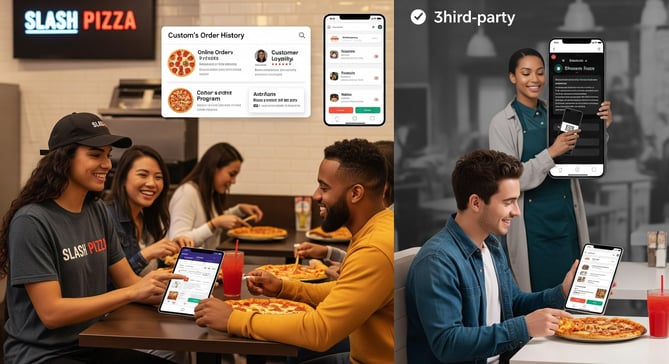Share this
Slash Pizza Beat Uber Eats at Its Own Game — Here's How They Did It

What if your biggest competitor wasn't another pizzeria—but the very apps you rely on to sell? That was the reality for Slash Pizza, a bold Latin American brand that turned the tables on Uber Eats by building their own delivery engine. In just 3 months, they grew online revenue by 73% and made their website the #1 sales channel.
Let’s break down how they pulled it off—and what your business can learn from it.
The Problem: Lost in the App Crowd

Slash Pizza was stuck in the same trap as thousands of independent restaurants:
High Fees, Low Visibility
Uber Eats and similar platforms charged 25–35% commission per order, eating directly into already thin margins. On top of that, the app experience buried them among hundreds of competitors, all fighting for the same customers with generic listings and discounts.
No Loyalty, No Data
Because the platforms controlled customer relationships, Slash Pizza had no access to buyer data. That meant no retargeting, no personalized offers, and no chance to build a brand community.
Flash Sale Dependency
To stay visible, they were constantly running app-based flash promotions. But those discounts further hurt margins and trained customers to only buy when there was a deal.
Conversion Struggles
Their listings looked like every other pizza place. No story. No personality. And poor conversion rates to match.
The result? A business that looked busy, but barely profited.
The Move: Build, Brand, and Own It

Slash Pizza made a courageous decision: stop renting customers, and start building an owned experience. Here's what they did.
Branded Online Ordering Website
They launched a fully customized, mobile-first website that matched their bold visual identity. With fast checkout, clear calls-to-action, and responsive design, it felt nothing like the clunky third-party app interface.
1-Click Reordering & Saved Favorites
Customers could now reorder their go-to pizza in one tap. This reduced friction and created habits around the brand.
Integrated Delivery & Auto-Dispatch
Orders placed on the site were automatically routed to nearby delivery drivers. Customers received live updates via SMS and push notifications, just like they'd expect from the big apps.
Loyalty Points, Coupons & CRM
Every direct order added points to a customer’s profile. Slash Pizza used these points to send automated email and SMS campaigns that drove repeat purchases.
Marketing Automation Tools
From "We miss you" winback flows to birthday discounts and limited-time offers, Slash Pizza finally had the power to market smarter.
The Results: 3 Months to a New Revenue Machine

Slash Pizza didn’t just survive the platform shift. They thrived.
+73% Online Revenue Growth
Within 90 days, online revenue soared as customers shifted from apps to the brand’s own site.
#1 Sales Channel = Their Website
The branded ordering platform quickly became their top channel, outpacing all app-based traffic.
0% Commission, Full Control
With every direct order, they kept the full margin. That meant higher profits without raising prices.
Direct Customer Relationships
They built a database of repeat buyers they could communicate with anytime, on their terms.
Increased Repeat Orders
Thanks to loyalty points, automation, and smoother UX, repeat order rates climbed significantly.
The Results: 3 Months to a New Revenue Machine
If you’re still relying on delivery apps to fuel your business, here’s what you can learn from Slash Pizza:
- Own your customer experience from the first tap to the final slice. Control equals consistency.
- Build once, profit forever. A branded site isn’t a one-time tool. It’s a long-term growth asset.
- Make apps optional, not essential. They’re a good backup—not your main strategy.
- Use loyalty tech to build habits. Points, offers, and reminders keep people coming back.
- You don’t need VC money to scale. You just need the right tools, strategy, and mindset.
Before vs After: The Slash Pizza Transformation
|
Metric |
Before (Apps) |
After (Own System) |
|
Online Revenue Source |
100% from apps |
70% from branded site |
|
Revenue Growth (3 months) |
Flat |
+73% |
|
Commission Fees |
25–35% |
0% |
|
Customer Loyalty |
None |
Powered by own CRM |
|
Repeat Orders |
Low |
Increased through automation |
Why It Worked: The Ownership Framework

What made Slash Pizza’s turnaround possible wasn’t magic. It was a shift in ownership mindset. Here’s the model:
- Visibility
Apps prioritize themselves. Your site prioritizes you. - Control
Control over delivery timing, UX, brand design, and customer data = control over profits. - Retention
Without ownership, you’re always paying to reacquire customers. With it, you can nurture lifetime value. - Differentiation
Your brand story can shine on your own turf—not in a feed of generic listings.
Own the tech. Own the data. Own the outcome.
Want to Do the Same?
Thousands of brands like Slash Pizza are flipping the script on third-party platforms. If you’re ready to:
- Grow with better margins
- Offer faster, smarter delivery
- Build loyalty and retention
- Take back control from delivery apps
Share this
- December 2025 (7)
- November 2025 (1)
- October 2025 (4)
- September 2025 (10)
- August 2025 (10)
- July 2025 (7)
- June 2025 (9)
- February 2025 (1)
- January 2025 (2)
- December 2024 (2)
- April 2024 (1)
- January 2024 (1)
- December 2023 (3)
- November 2023 (15)
- May 2023 (21)
- April 2023 (8)
- March 2023 (5)
- February 2023 (67)
- January 2023 (156)
- July 2022 (20)
- June 2022 (60)
- April 2022 (2)
- February 2022 (17)
- January 2022 (26)
- December 2021 (15)
- November 2021 (9)
- October 2021 (1)
- June 2021 (1)
- May 2021 (3)
- March 2021 (5)
- February 2021 (5)
- November 2020 (5)
- October 2020 (1)
- September 2020 (2)
- July 2020 (1)
- February 2020 (1)
- May 2019 (3)
- April 2019 (3)
- March 2019 (1)
- January 2019 (11)
- November 2018 (1)
- September 2018 (4)
- August 2018 (4)
- July 2018 (6)
- June 2018 (4)
- May 2018 (18)
- April 2018 (10)
- March 2018 (9)
- February 2018 (14)
- January 2018 (19)
- December 2017 (10)
- November 2017 (10)
- October 2017 (18)
- September 2017 (12)
- August 2017 (17)
- July 2017 (5)
- June 2017 (6)
- May 2017 (2)
- January 2017 (1)



